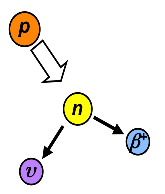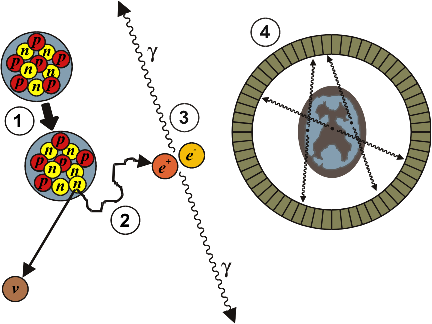Positron Annihilation
Radiotracers used in PET imaging are all positron emitters. That is, they contain unstable isotopes that decay by emitting a positron, which is the antimatter version of an electron, and thus has a positive charge. The positron is emitted when a proton decays into a neutron. The nuclear equation is therefore:

A proton decays into a neutron by emitting a positron and a neutrino.
This reaction takes place in isotopes that are neutron-deficient, and would therefore be more stable by losing a proton and gaining a neutron. As a result, all PET radiotracers have a lower mass number than their stable isotopes. It is this emission of a positron that makes PET imaging possible.
When a positron is emitted by a PET radiotracer, it travels a few millimetres in the body before it has lost enough energy to interact with an electron. This interaction is called an annihilation reaction, as both the positron and the electron transform into energy. This energy takes the form of two photons (particles of light) travelling in opposite directions, each with an amount of energy equal to E=mc2=511keV, where m is the mass of the electron (or the positron, as they have identical masses).

An atom of Carbon-11 decays into an atom of Boron-11 (1) by positron emission. The positron travels a few mm in the body (2) before it has lost enough energy to interact with an electron in an annihilation event (3). This produces two photons travelling in opposite directions, each with an energy of 511keV. When the PET ring detects two photons of this energy, it draws a line-of-response along the line between them, and uses these to create the image (4).
